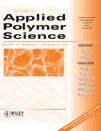Mechanical and morphological properties of epoxy resins modified by poly(phthalazinone ether sulfone ketone)
Yajuan Xu
Department of Polymer Science and Materials, Dalian University of Technology, Dalian 116012, China
Search for more papers by this authorGongxiong Liao
Department of Polymer Science and Materials, Dalian University of Technology, Dalian 116012, China
Liaoning Province Engineering Center of High Performance Resins, Dalian 116012, China
Search for more papers by this authorTiesheng Gu
Department of Polymer Science and Materials, Dalian University of Technology, Dalian 116012, China
Search for more papers by this authorLiang Zheng
Department of Polymer Science and Materials, Dalian University of Technology, Dalian 116012, China
Search for more papers by this authorCorresponding Author
Xigao Jian
Department of Polymer Science and Materials, Dalian University of Technology, Dalian 116012, China
Liaoning Province Engineering Center of High Performance Resins, Dalian 116012, China
Department of Polymer Science and Materials, Dalian University of Technology, Dalian 116012, China===Search for more papers by this authorYajuan Xu
Department of Polymer Science and Materials, Dalian University of Technology, Dalian 116012, China
Search for more papers by this authorGongxiong Liao
Department of Polymer Science and Materials, Dalian University of Technology, Dalian 116012, China
Liaoning Province Engineering Center of High Performance Resins, Dalian 116012, China
Search for more papers by this authorTiesheng Gu
Department of Polymer Science and Materials, Dalian University of Technology, Dalian 116012, China
Search for more papers by this authorLiang Zheng
Department of Polymer Science and Materials, Dalian University of Technology, Dalian 116012, China
Search for more papers by this authorCorresponding Author
Xigao Jian
Department of Polymer Science and Materials, Dalian University of Technology, Dalian 116012, China
Liaoning Province Engineering Center of High Performance Resins, Dalian 116012, China
Department of Polymer Science and Materials, Dalian University of Technology, Dalian 116012, China===Search for more papers by this authorAbstract
A series of blends have been prepared by adding a novel thermoplastic poly(phthalazinone ether sulfone ketone) (PPESK) in varying proportions to diglycidyl ether of bisphenol A epoxy resin (DGEBA) cured with p-diaminodiphenylsulfone (DDS). All the blends showed two-phase structures characterized by differential scanning calorimetry (DSC) and scanning electron microscopy (SEM). Addition of the PPESK resulted in great enhancement of glass transition temperatures (Tg) both in the epoxy-rich phase and in the PPESK-rich phase by reason of the special structure of PPESK. There was moderate increase in the fracture toughness as estimated by impact strength. Fracture mechanisms such as crack deflection and branches, ductile microcracks, ductile tearing of the thermoplastic, and local plastic deformation of the matrix were responsible for the increase in the fracture toughness of the blends. © 2008 Wiley Periodicals, Inc. J Appl Polym Sci, 2008
References
- 1 Sankaran, S.;Chanda, M. J Appl Polym Sci 1990, 39, 1635.
- 2 Chikhi, N.;Ellahi, S. F.;Bakar, M. Eur Polym Mater 2002, 38, 251.
- 3 Arias, M. L.;Frontini, P. M.;Williams, R. J. J Polym 2003, 44, 1537.
- 4 Giannotti, M. I.;Bernal, C. R.;Oyanguren, P. A.;Galante, M. J Polym Eng Sci 2005, 45, 1312.
- 5 Min, B.-G.;Hodgkin, J. H.;Stachurski, Z. H. J Appl Polym Sci 1993, 50, 1065.
- 6 Park, S. J.;Kim, H. C. J Polym Sci Part B: Polym Phys 2001, 39, 121.
- 7 Kim, B. S.;Inoue, T. Polymer 1995, 36, 1985.
- 8 Mimura, K.;Ito, H.;Fujioka, H. Polymer 2000, 41, 4451.
- 9
Shin, S.;Jang, J.
J Appl Polym Sci
1997,
65,
2237.
10.1002/(SICI)1097-4628(19970912)65:11<2237::AID-APP21>3.0.CO;2-Z CAS Web of Science® Google Scholar
- 10 Chen, M. C.;Hourston, D. J.;Sun, W. B. Eur Polym Mater 1995, 31, 199.
- 11 Wang, M. H.;Yu, Y. F.;Wu, X. G.;Li, S. J Polymer 2004, 45, 1253.
- 12 Song, X. Z.;Zheng, S. X.;Huang, J. Y.;Zhu, P. P.;Guo, Q. P. J Appl Polym Sci 2001, 79, 598.
- 13 Francis, B.;Thomas, S.;Ramaswamy, J. J. R.;Rao, L. V. Polymer 2005, 46, 12372.
- 14
Girard-Reydet, E.;Vicard, V.;Pascault, J. P.;Sautereau, H.
J Appl Polym Sci
1997,
65,
2433.
10.1002/(SICI)1097-4628(19970919)65:12<2433::AID-APP15>3.0.CO;2-1 CAS Web of Science® Google Scholar
- 15 Bonnet, A.;Lestriez, B.;Pascault, J. P.;Sautereau, H. J Polym Sci Part B: Polym Phys 2001, 39, 363.
- 16 Varley, R. J.;Hodgkin, J. H.;Simon, G. P. Polymer 2001, 42, 3847.
- 17 Zhang, D. H.;Jia, D. M. J Appl Polym Sci 2006, 101, 2504.
- 18 Saxena, A.;Francis, B.;Rao, V. L.;Ninan, K. N. J Appl Polym Sci 2006, 100, 3536.
- 19 Meng, Y. Z.;Hay, A. S.;Jian, X. G.;Tjong, S. C. J Appl Polym Sci 1997, 66, 1425.
- 20 Jian, X. G.;Chen, P.;Liao, G. X.;Zhu, X. L.;Zhang, S. H.;Wang, J. Y. Acta Polym Sinica 2003, 4, 469.
- 21 He, W.;Liao, G. X.;Jian, X. G.;Feng, X. B. J Polym eng 2006, 26, 617.
- 22 Varley, R. J.;Hodgkin, J. H.;Hawthorne, D. G.;Simon, G. P. J Polym Sci Part B: Polym Phys 1997, 35, 153.
- 23 Sridhar, K. S.;Thein, K. J Appl Polym Sci 2000, 77, 1257.
- 24 Pean, G.;Eceiza, A.;Valea, A.;Remiro, P.;Oyanguren, P.;Mondragon, I. Polym Int 2003, 52, 1444.
- 25
Wu, S. J.;Lin, T. K.;Shyu, S. S.
J Appl Polym Sci
2000,
75,
26.
10.1002/(SICI)1097-4628(20000103)75:1<26::AID-APP4>3.0.CO;2-3 CAS PubMed Web of Science® Google Scholar
- 26 Bucknall, C. B.;Partridge, I. K. Polymer 1983, 24, 639.
- 27 Andres, M. A.;Garmrndia, J.;Valea, A.;Ecwiza, A.;Mondragon, I. J Appl Polym Sci 1998, 69, 183.
- 28 Xu, J.;Wu, H.;Mills O. P.;Heiden P. A. J Appl Polym Sci 1999, 72, 1065.
- 29
Oyanguren, P. A.;Aizpurua, B.;Galante, M. J.;Riccardi, C. C.;Cortazar, O. D.;Mondragon, I.
J Polym Sci Part B: Polym Phys
1999,
37,
2711.
10.1002/(SICI)1099-0488(19991001)37:19<2711::AID-POLB1>3.0.CO;2-5 CAS Web of Science® Google Scholar
- 30 Francis, B.;Thomas, S.;Asari, G. V.;Ramaswamy, R.;Jose, S.;Rao, V. L. J Polym Sci Part B: Polym Phys 2006, 44, 541.




